Shelburne



Shelburne


PATRICK BILOW STAFF WRITER
The Falls Road pedestrian bridge over the LaPlatte River was officially unveiled Saturday morning after 14 years of planning and fluctuating project costs.
A group of cyclists and walkers met at LaPlatte Circle, a nearby trailhead, before the unveiling and paraded to the bridge on a series of trails and sidewalks. They were joined by a swelling crowd of locals who came out to celebrate the long-awaited bridge on a sunny fall morning.
“There were numerous times throughout the 14 years where we
thought this was going to die on the vine,” said Kevin Boehmcke, member of the Bike and Pedestrian Paths Committee in Shelburne, who addressed the crowd Saturday. “But with persistence and community support, we were able to make this happen.”
The effort to build a bridge on Falls Road over the LaPlatte River dates to 2010 when a handful of new developments in the neighborhood were ushering in new residents and families.
There was a lack of pedestrian connection to downtown Shel-
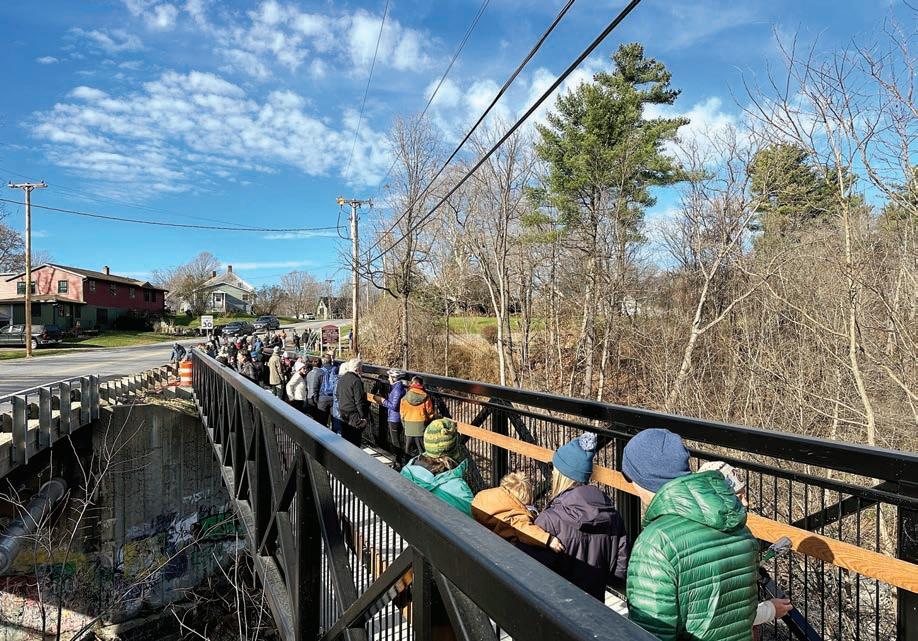
See BRIDGE on page 12
SARAH MEARHOFF VTDIGGER
A week and a half after Vermont voters eviscerated their supermajority, Senate Democrats convened Saturday to reflect on their election losses and chart a new course ahead of the 2025 legislative session. They voted to retain one top leader — but jettisoned another. Saturday’s caucus at the Statehouse was the first time Democrat-
ic senators-elect had gathered after what Sen. Becca White, D-Windsor, called “an exceptionally difficult, tragic election night.” Republican candidates flipped six Senate seats, ousting four incumbents, and established a new partisan breakdown in the chamber of 17-13 — the narrowest margin Democrats have held in nearly a quarter-century.
Seeing a need to change course, the caucus on Saturday voted out

its incumbent majority leader, Sen. Alison Clarkson, D-Windsor, who has held the post for four years. In her place, they elected Sen. Kesha Ram Hinsdale, D/P-Chittenden Southeast.
All the votes Saturday were conducted by secret ballot. Democrats elected Hinsdale their new majority leader by a vote of 9-7, with one member abstaining.
In his nominating speech for Hinsdale, Sen. Andrew Perchlik,
Pancake
D/P-Washington, echoed what had already become a common refrain in the room Saturday morning: that on the campaign trail, Vermont Democrats failed at messaging and communicating to voters and combatting criticism from their Republican challengers and Gov. Phil Scott, also a Republican.
Perchlik said of Hinsdale, “I don’t think there is anybody in this room that’s better at communication and messaging.”

He said he would also be “honest” about “the criticism that I heard of Sen. Hinsdale, and one that I’ve had myself, and that is that she’s a bit of an overachiever, and she’s ambitious.”
“I think that maybe there’s positions where you don’t want those characteristics in a person,” Perchlik said. “But I think we’re talking
See HINSDALE on page 2




continued from page 1
about electing a political leader, for a political caucus, in a political body, working in politics, and we want somebody that is ambitious.”
With her new leadership position, Hinsdale will most likely forfeit her current position as chair of the Senate Committee on Economic Development, Housing and General Affairs — a post from which she has been able to shape major policies in the chamber. That’s because of a longstanding tradition in the Senate, dating back to 1997, of caucus leaders not chairing policy committees to prevent them from accumulating too much power.




Ram Hinsdale tried to change that tradition Saturday. In an unusual move, senators voted on a piece of internal guidance that would have allowed caucus leaders to serve as committee chairs, as well. Hinsdale urged her colleagues to vote yes.
In a speech to her colleagues urging their ‘yes’ votes, Hinsdale chalked up the question to “basic math” in the 30-member chamber.
“We have 17 members of our caucus. When you subtract our new members … you land with 14 members of our caucus, and you subtract the rest of the (leadership) positions … you’re left with 11. Eleven Democrats to distribute leadership roles in each position,” Hinsdale said. “There are 11 committees.”
From a “simple mathematical perspective,” she concluded, upholding the 27-year-old tradition would be “putting colleagues from the other side of the aisle further in line for a leadership role overseeing our policy agenda, frankly.”
Clarkson, who made the initial push for the caucus to vote on the
matter Saturday, said that, given the 17-13 makeup of the Senate, that’s fair. Already, Sen. Russ Ingalls, R-Essex, chairs the Senate Institutions Committee.
“This is nothing new, and nothing new with these numbers,” Clarkson said. “Given the number of Republicans that have been elected, it makes sense that there will be at least one — we’ve always had at least one Republican chair — and … my guess is there will be a second.”
What’s important to Clarkson, she said, is “empowering our caucus and empowering individual growth. I think it’s essential that we grow our leadership in this caucus.”
Ultimately, senators voted 9-6, with two abstentions, to defeat the proposed change to allow a caucus leader to also serve as a committee chair.
Democrats also opted not to make a change at the top of the Senate’s hierarchy.
Senate President Pro Tempore Phil Baruth, D/P-Chittenden Central, faced no challenger from within the caucus for his nomination to serve a second biennium leading the Senate. As the Democratic caucus’s nominee, Baruth will face a vote by all 30 members of the Senate on the first day of the 2025 legislative session in January.
But even within the caucus, his nomination was not unanimous. Fifteen senators voted ‘yes’ to renominate Baruth to the post, while two abstained. Following the vote, Baruth said that 15-2 is “a number that we should all have in our minds going forward, because if we vote 15-2 on the floor, we lose whatever bill is in front of us.”
With 13 Republicans in the chamber, Baruth noted that two Democrats splitting from the caucus would create a 15-15 tie on the floor. Republican Lt. Gov.elect John Rodgers would then break such a tie.
“I understand I did not get a unanimous vote, that two people had their reasons,” Baruth said. “Every bill that comes to you, you may have reasons why you might not want to vote for it. But we’re in a situation where the good of the caucus and the bills that you want to pass out of your committee are going to need you to be a little more amenable to other people’s bills. You’re going to have to stretch sometimes.”
Also on Saturday, Democrats elected White the caucus’s new whip, with 14 voting in favor and three abstaining. Perchlik, who had previously held the post, did not seek it again.
Democrats also nominated Sen. Ginny Lyons, D-Chittenden Southeast, to serve as the third member of the powerful, three-member Committee on Committees.
That panel, which also includes the pro tem and lieutenant governor, draws up Senate committee assignments and chairmanships, playing a major role in choreographing the chamber’s policy direction. Sixteen Democratic senators-elect voted in favor of Lyons’ nomination, while one abstained. Lyons will also face a vote on the Senate floor in January before she can claim the title.
She would replace retiring Sen. Jane Kitchel, D-Caledonia, who held the position only briefly after
LIBERTY DARR STAFF WRITER
Advocates are demanding that local and state leaders take immediate action for a safer Shelburne Road for pedestrians and cyclists following a fatal crash in South Burlington last week.
An on-duty Shelburne police sergeant, Kyle Kapitanski, was southbound and headed toward Shelburne when he struck and killed a bicyclist, Sean Hayes, 38, of Burlington, at Fayette Drive 2:45 a.m. Monday, Nov. 11.
(See related story 5)
While the Vermont State Police are still investigating the crash, the advocacy group Local Motion — Vermont’s statewide advocate for active transportation and safe streets — launched a petition last week that has garnered roughly 600 signatures calling on the Vermont Agency of Transportation, Chittenden County Regional Planning Commission and community leaders in South Burlington, Shelburne and Burlington to find a solution.
The group says that this is the fourth fatal crash that has involved a pedestrian at, or very close to, that intersection in five years. In December 2020, Jermee Slaughter was killed while walking when a driver hit them and fled the scene, leaving Slaughter in the roadway where they were hit by another
continued from page 2
the resignation last year of longtime Sen. Dick Mazza, D-Grand Isle.
After selecting caucus leaders, senators-elect then shared with one another their priorities for the upcoming legislative session. They each rattled off a familiar list of policy goals — chief among them, to reduce Vermonters’ property tax burden and reform the state’s education finance structure.
Baruth told his caucus that he sees the state’s property tax conundrum as a “de facto emergency” — and said he plans to treat it as such from the first day of session. He proposed to clear the agendas of the Senate’s education, finance and appropriations committees at the start of the session,
driver. In September 2023, Chriss Zuckerman was killed by a driver while crossing at Fayette Drive.
Last March, Joseph Byrd Allen, also known to the Burlington community as “Byrdman,” was hit and killed while biking on Shelburne Road, in front of Pauline’s Cafe and Restaurant by a driver who fled the scene.
“We know there are numerous causes for each of these crashes, and while human behavior is often blamed, it is an incomplete explanation and an unhelpful one if we are serious about preventing death,” the group wrote in its petition.
According to their data, bike and pedestrian fatalities within the state remain relatively low, so it’s very clear when there is a problematic “hot spot.”
“Basically, it’s Shelburne Road and Routes 4 and 7 in Rutland,” he said. “Both of those segments of roadway are very similar in context. It’s kind of a suburban strip mall and has a very similar design in terms of multiple lanes, 35 to 45-ish miles per hour. Nationwide, we see that context and design is the most dangerous for people outside of cars.”
Weber noted that making changes to the
See SHELBURNE ROAD on page 12


and offer a full week of testimony to the Scott administration to hear solutions from the governor himself.
The idea, Baruth said, would be to reach an agreement between the Republican administration and Democratic majorities at the start of the session, rather than the end. No longer holding a supermajority, legislative Democrats won’t be able to reliably override a veto from Scott — and so “no one is going home without a Phil Scott-approved tax plan,” Baruth said.
“If there is a message in this election, I believe it was that the voters wanted the governor’s ideas moved to the top of the agenda,” Baruth said. “That is literally what I’m suggesting.”


















Total reported incidents: 61
Traffic stops: 13
Warnings: 14
Tickets: 1
Arrests: 1
Medical emergencies: 17
Mental health incidents: 2
Suspicious incidents: 11
Directed patrols: 21
Citizen assists: 3
Motor vehicle complaints: 1
Car crash: 2
Animal problem: 3
Noise disturbance: 0
Unlawful Mischief: 0
Theft: 1
Harassment: 0
Vandalism: 1
Property damage: 0
Fraud: 2
Alarms: 7
Pending investigations: 4
911 Hang-up calls: 1
Nov. 11 at 2:23 p.m., a caller reported a domestic disturbance in a neighboring room at the T-Bird Motel.
Nov. 11 at 6:00 p.m., a 911 caller reported that someone trespassed from Harbor Place was on the property. The individual had left before the officer arrived.
Nov. 12 at 9:54 a.m., vandalism
was reported at Davis Park.
Nov. 12 at 3:14 p.m., someone reported suspicious individuals near Kinney Drugs. Lisa Cota, 46, of Winooski was arrested on an outstanding warrant.
Nov. 12 at 10:20 p.m., a disturbance was reported at North Star Motel, and officers determined a person there was having a mental health issue.
Nov. 13 at 1:08 p.m., someone reported a theft from their vehicle on Henry Street.
Nov. 13 at 5:17 p.m., a caller reported an injured dog on Shelburne Road. Officers located the dead animal and its owner was notified.
Nov. 15 at 10:46 p.m., a report of a domestic disturbance on Henry Street turned out to be people watching a sporting event.
Nov. 16 at 3:10 a.m., cows were in the road near Dorset Street and Cheesefactory Road. Their owner came and retrieved them.
Nov. 17 at 5:30 p.m., Shelburne police located a stolen vehicle and its operator and turned both over to Middlebury police.
Nov. 17 at 4:33 p.m., cows on Route 116 were brought back to their pasture by their owner.
Serving the community of Shelburne A publication of Vermont Community Newspaper Group LLC shelburnenews.com
Advertising Wendy Ewing wendy@shelburnenews.com (802) 985-3091 x12
Advertising Director Judy Kearns judy@otherpapersbvt.com (802) 864-6670 x21
News Editor Tommy Gardner
Staff Writers
Aaron Calvin Liberty Darr Patrick Bilow
Production Manager Stephanie Manning stephanie@shelburnenews.com
Editor/Publisher Gregory Popa gpopa@stowereporter.com
Billing inquiries Leslie Lafountain leslie@stowereporter.com (802) 253-2101
Advertising submission deadline: Friday at 5 p.m. advertising@shelburnenews.com classifieds@shelburnenews.com
Editorial submission deadline: Friday at 5 p.m. news@shelburnenews.com
Calendar submission deadline: Friday at 12 p.m. news@shelburnenews.com
Contact: 1340 Williston Road South Burlington, VT 05403 (802) 985-3091
PATRICK BILOW STAFF WRITER
Kyle Kapitanski, a sergeant with the Shelburne Police Department who struck and killed a cyclist in a cruiser on Shelburne Road last week, has been placed on paid administrative leave, according to Shelburne police chief Mike Thomas.
The cyclist was identified as Sean Hayes, a 38-year-old resident of Burlington.
Kapitanski was put on paid leave last Tuesday, one day after the incident. Thomas spoke with Kapitanski Monday night, but the
sergeant was officially notified of his leave by email.
During his leave, Kapitanski will be compensated at his normal rate for a 40-hour work week. Thomas said the sergeant will remain on leave until an investigation into the incident is complete.
Vermont State Police is handling the investigation. No new details are available as of Tuesday, according to Adam Silverman, VSP’s public information officer.
Kapitanski was headed south along Shelburne Road in his cruiser when he hit Hayes, who
was towing a trailer behind his bicycle near Fayette Drive about 2:45 a.m. on Nov. 11.
Police said Hayes was also headed toward Shelburne. According to a press release, the road was wet, and it was raining at the time of the fatal accident. State police impounded Kapitanski’s police cruiser. Kapitanski, 40, joined Shelburne police during the summer 2022, after previously serving as police chief in Richmond for one year.
Mike Donoghue contributed to this report.
The Chittenden County Sheriff’s office is warning of a recent scam where citizens are being contacted about fake warrants for their arrest.
On Nov. 14, a scammer called someone in the medical field saying they’d ignored a court subpoena and must now pay a fine to avoid arrest and loss of their medical license.
On two recent occasions individuals paid the scammers $3,500 and $18,000. The scammers used both the names of sheriff’s department employees and fake names.
The department is telling people who receive one of these calls to hang up and never provide personal information such as date of birth, Social Security numbers, bank or credit card information.
Law enforcement agencies never clear arrest warrants or court cases by asking for money in any form, including wire transfers, money orders, Venmo, bitcoin, PayPal, Apple Pay or other over-the-phone payment options.
Report these types of incidents to the Vermont Attorney General’s Office at 800-649-2424 or 802-656-3183.
With our grand opening set for early 2025, we’re seeking driven, compassionate team members to bring Vergennes Grand to life. At the fair, we’ll accept applications and conduct interviews for positions across all departments.
more information and to download a job application form.


Guest Perspective
Margaret MacLean
Roxbury parents can meet most of the challenges of school mornings, from organizing breakfast to helping their children remember assignments and lunches. Warming up the car for the up to 4-mile drive to the nearest bus stop is also on the to-do list.
But one part is breaking their hearts: the 2 hours and 15 minutes per day their children now spend on the bus getting to and from school in Montpelier. Endless hours on a school bus are not what they want for their children. It’s not what a Vermont childhood should be.
When the Montpelier and Roxbury school districts merged under the school consolidation law Act 46, Roxbury residents were assured their rural school would receive equal treatment in the new district. But since then, the Montpelier-dominant board made the sudden decision to close Roxbury’s K-4 elementary school last spring, and families in the small town have come face-to-face with the inequities caused by rural school closures. Even the smallest children must endure punishingly long bus rides, made worse by the fact that in this 42-square mile town filled with dirt roads, Montpelier’s buses only drive on pavement.
• In the long term, are less likely than their peers to complete college and secure a job
• Face negative impacts from declining family and community engagement.
Closing schools doesn’t save money. Children from closed schools still need an education. National research shows that per-pupil spending tends to increase when schools close, while anticipated cost efficiencies from economies of scale rarely materialize. Transportation costs increase, the promised wider opportunities cost money and empty public buildings need to be maintained. School closures most often result in the redistribution of where money is spent, rather than financial savings.
Scapegoating small rural communities for Vermont’s fiscal crisis flies in the face of equity and is not based on a factual analysis of the problem.
That’s right. Montpelier’s buses do not go on dirt roads.
But beyond busing issues, many parents feel dismissed by a now-distant Montpelier school system, and the town is still searching for a sustainable use for the school building that was once the heart of their community.
Roxbury greenhouse owner Tom Frazier put it bluntly. “We merged with Montpelier in good faith. The situation we are in now, they have closed our school — is a nightmare.”
Roxbury is not alone. Across the U.S., when rural schools have been targeted for closure, similar patterns have emerged. Research shows that closing schools is damaging to children. Studies of school closures across the U.S. show that students:
• Experience a loss of connectedness with peers and community.
• Face increased mental health challenges.
• In the short term, have lower test scores, worse attendance and behavioral issues.
Closing schools increases inequity. Research finds that students experiencing poverty, students of color and those with special needs are most negatively impacted by school closures.
Closing schools destroys communities. In communities where schools are closed, research points to depopulation, declining home values, eroding social capital and problems with attracting and retaining families with children.
Closing schools without due process results in unintended consequences. An inclusive, open-minded analysis of the pros, cons and alternatives to school closure is crucial to avoiding unintended consequences. Examination of winter transportation (likely to make long bus rides even longer), creative options such as retaining rural schools to house licensed child care, pre-school and K-2 students, additional community-oriented alternatives for school buildings, and other research should be documented and presented as part of a choice for voters. And a town vote on closing a town’s school is an essential element to ensure buy-in to a balanced, sustainable and fair solution.
Vermont’s children deserve better. Research shows that multi-age classrooms are developmentally appropriate settings for young children, and many small schools are cost effective and among the best performing schools in Vermont. Small schools for elementary students can be exemplary schools.
Scapegoating small rural communities for Vermont’s fiscal crisis flies in the face of equity and is not based on a factual anal-


Guest Perspective
Elayne Clift
Usually, around this time, I think about writing my cheery Christmas letter to share the highlights of another year in our family’s life. This year is different. I’m still trying to grasp what just happened and what it will mean for all of us.
My initial reaction was blurted out in staccato texts to friends who were in the same state as I was: “Stunning!” “Horrific!” “Devastating!” “Dangerous!” Then I entered an emotionally strange place that felt like a Venn diagram in which anxiety and numbness meet in the center of a space that felt more like despair. Now I’m asking myself how and why the shock of the election happened.
It started with questions. How could a 34-time convicted felon and a man who was found guilty of sexual assault be able to run for president? Why was the U.S. Justice Department so slow in moving forward on his trials? How could the Supreme Court grant him carte blanche to do whatever he wanted to if he were president again? How could people vote
for someone who lies incessantly, whose language is vile, whose racism and misogyny are so blatant, who dreams of being a dictator, not be enough to stop him?
Then I moved to what I fear most. People like Elon Musk, Robert F. Kennedy Jr., Steven Miller, the authors of Project 2025, and other-like minded tyrants taking control of every government agency and firing thousands of career civil servants.
I worried about what it would mean to close or limit agencies like the Environmental Protection Agency, Department of Education, National Oceanic and Atmospheric Administration, and Federal Emergency Management Agency, and to ignore the ever-worsening climate crisis.
I thought about a country with such a broken, for-profit health care system that would result in skyrocketing illnesses and deaths (with no data to prove it), and millions of people suffering as a result. I wondered how bad it would get without vaccinations, fluoride, Medicaid, reduced Medicare and no insurance.
I thought of the women who will have no agency over their own lives, and I imagined the women who would die
Newly elected representative says thanks
To the Editor:
To all the constituents of St. George and Shelburne, I wanted to extend a heartfelt thank you for electing me to the House of Representatives. I believe we have an incoming group of legislators who understand we must collaborate in a spirit of compromise and respect.
We all know the challenges ahead:

Gomer & Gunther
affordability, housing, education funding and health care. Not one will be easy to fix, but I will do my utmost to stay positive, keep open lines of communication, work diligently to find solutions and represent you to the best of my ability.
I am excited for the opportunity you have given me.
Shawn Sweeney Representative-elect, Chittenden 7
We understand the love you have for your pets and the importance they hold in your life. Our compassionate staff is devoted to easing the difficulties at this challenging time.
Our staff is here for you 24/7 Tiger & Buster

because they couldn’t get reproductive health care when they were in crisis or who would be jailed for having a miscarriage. I worried about a reprise of the Comstock Act that would ban abortion nationally and deny women any form of birth control, except sterilization, which some young women have already resorted to.
I worried about people of all ages who would be rounded up, separated and held in the equivalent of prisons indefinitely. I am really worried about revenge politics, roundups of opposition leaders and activists, the disappearance of news outlets and random violence.
As Robert Reich said in a piece in The Guardian the day after the election, “Countless people are now endangered on a scale and intensity unheard of in modern America.”
We have what it takes to meet and overcome this moment as our elders and ancestors did under unthinkably difficult circumstances.
I also worried mightily about our lost standing in the global community and the threat of an expanded war in the Middle East while Ukraine is handed to Putin who can then march into the NATO countries to start a Third World War.
How did we allow this to happen? I came to this conclusion: We are a country conceived and birthed by smart, visionary, educated men who were elite white supremacists wedded to racism, misogyny, religious singularity, patriarchy and conformity.
What we are seeing now, it seems to me, is the underbelly of an America that has always flourished, and has grown in modern times, driven by color, caste, economic advantage or disadvantage, religious beliefs, ethnicity, power and corrupted politics, all of which have divided us into Us and Them. That makes for a dangerous, disquieting and increasingly binary way to live. It stokes fear, limits compassion and clear thinking, and people like Donald Trump rely on it for their own gains.
MACLEAN
ysis of the problem. Enrollment decline exists in schools of all sizes, all over Vermont. Schools of all sizes should be expected to step up to address enrollment decline — not just look to closing their neighbors’ smaller schools as an easy fix.
Vermont must provide an excellent public education system that prepares children for success, supports families and thriving communities and is delivered at a cost hard-working Vermonters can afford. Leaders’ sense of urgency in finding new models is merited and laudable. However, the burden of change must be equitable and addressed by communities large and small.
As an Instagram post said the day after the election, “America has showed its true character and it’s heartbreaking,” So where do I go from here? My answer begins with my belief that resistance doesn’t die, it re-emerges when it is vital to survival. Early Americans knew that when they threw tea into Boston harbor. Slaves resisted in various ways including dancing and drumming. People stood up to McCarthyism and to an American fascist movement in the 1930s and 1940s.
We started labor movements and unions to protect workers, and we made sure women could vote by refusing food and enduring forced feeding. We resisted a war in Vietnam and successfully ended it. It’s in our DNA in huge numbers when things get bad because, most of us refuse oppression, discrimination, exploitation and evil and choose instead to embrace freedom and democracy.
There are some among us who don’t get that yet, but they will soon see how powerful and effective it is. Paraphrasing Billy Wimsatt, executive director of the Movement Voter PAC the day after the election, we have what it takes to meet and overcome this moment as our elders and ancestors did under unthinkably difficult circumstances. We can draw on their strength and wisdom as we chart our way forward and join what is likely to be one of the largest resistance movements in history.
For now, we must take a breath and remember all we did together to avert this outcome. In that spirit let’s comfort each other as we regroup before continuing the fight for a compassionate country grounded in equality, justice and sustainable freedom and democracy.
Elayne Clift is a Vermont-based writer.
continued from page 5 Shop local and please remember
Closing Vermont’s rural schools is an “answer” that does not fix the problem. It simply creates different ones.
Margaret MacLean is a retired Vermont teacher and award-winning principal. She is the founding executive director of the Vermont Rural Education Collaborative, a past employee of the Rural School and Community Trust and served on the Vermont State Board of Education. She lives in Peacham. If you would like to receive a copy of the research supporting these points, email vtschoolsrock@gmail. com.
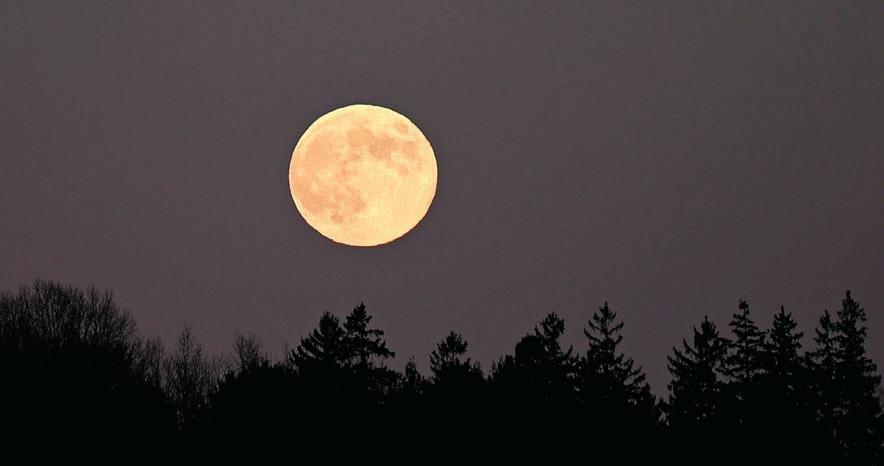
Mary Alexandrides
Mary Alexandrides of South Burlington died peacefully on Wednesday, Nov. 13, 2024. She was 98 years old.
Mary was born on Dec. 9, 1925, in Syracuse, N.Y., where her parents settled after emigrating from Italy. She was predeceased by her husband, the love of her life, Alexander Peter Alexandrides.
Mary was a graduate of North High School and the Bryant & Stratton Business Institute where she received her associate’s degree in computer programming.
From 1970 to 1985, Mary served as the commissioner of licenses for the city of Syracuse.
Mary was a loving wife and mother who introduced her daughters to the arts, sewing and cook-

ing. She had a wonderful sense of style and was an excellent seamstress, making beautiful clothing for herself, her daughters and their Barbie dolls. She adored her grandsons and her great granddaughters.








Mary was devoted to her family and will be remembered by the many friends she made in Vermont over the years.
Mary is survived by her daughters, Christine Faris, and Rita Daley (Paul) of Shelburne; her grandsons, Alex Faris, Andrew Faris (Madeline) and Thomas Daley; two great granddaughters; and several nieces and nephews.
Funeral services will be held on Friday, Nov. 22, 2024, at 11 a.m. at Trinity Episcopal Church in Shelburne. Interment will be private.
The family requests, in lieu of flowers, memorial contributions be made to the Shelburne Museum, Shelburne, or the McClure Miller Respite House, Colchester.
To send online condolences, please visit readyfuneral.com.
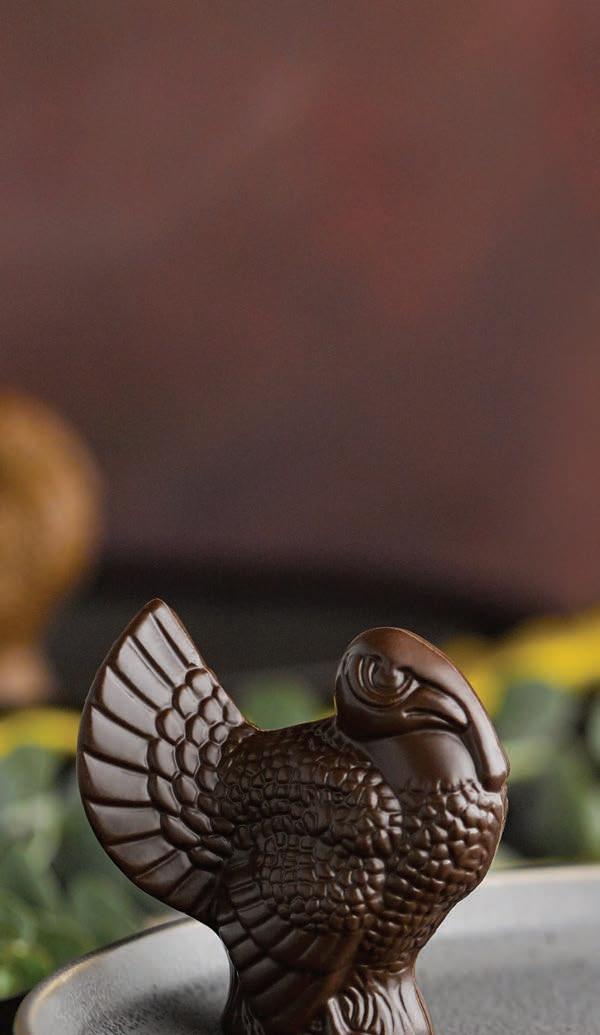


Get coffee with Lalley, Sweeney
Rep. Kate Lalley and Rep.elect Shawn Sweeney invite Shelburne residents to share coffee, concerns and hopes for the upcoming 2025 legislative session at Sweeney Designbuild, 5061 Shelburne Road, Shelburne on Saturday, Nov. 23, from 8-10 a.m.
For more information, email Sweeney at shawnforhouserep@ gmail.com or call 802-343-0775.
Bella Voce celebrates its 20th anniversary season with a program that includes a performance of Vivaldi’s venerated classic, “Gloria,” a timeless piece for women’s voices with trumpet, oboe, strings and continuo.
Joining Bella Voce is the University of Vermont’s String Ensemble, under the direction of Dr. Yutaka Kono. In addition, the concert will feature a variety of jubilant songs of the season by Robert De Cormier, Dan Forrest, Randol Bass and more, at the McCarthy Arts Center, St. Michael’s College, 18 Campus Road, in Colchester, on Sunday, Dec. 8 at 3:30 p.m.
For information, go to https:// bit.ly/4fMVqQ6.
The Vermont Agency of Education is holding three additional sessions in Chittenden and Windham counties through its Listen and Learn Tour.
The tour offers an opportunity for the public to share its thoughts and help the agency craft a strategic plan that reflects the priorities and needs of Vermont communities.
Upcoming sessions include:
• Dec. 3: King Street Center, Burlington
• Dec. 4: Champlain Valley Union High School, Hinesburg

Join Vermont’s Jane Austen Society for a birthday tea on Sunday, Dec. 8, 1-3 p.m., with pianist Donna Chaff, at the Charlotte Senior Center. The program, “Musical Jane,” will feature music from the life, novels and film adaptations of Austen. Chaff is an avid Austen fan, a member of the society and enjoys researching music of the Regency Era. She has been a music educator for over 35 years and has performed concerts in the U.S., Italy, Austria and Greece. She was the 2011 Massachusetts recipient of the Excellence in General Music Award. The event is free and open to the public and will feature light refreshments. Learn more at bit.ly/4fyR6nJ.
• Dec. 10: virtual meeting
All the meetings will take place from 6-8 p.m. Each will begin with an introduction, followed by breakout sessions on topics related to student achievement and support, career and college readiness, school budgets, among other priorities.
Pre-registration is encouraged using the online registration form at bit.ly/3UEGQ51.
Education and Enrichment for Everyone offers Dr. Richard Plumb, president of St. Michael’s College, who will give a talk on

“Opportunities and Challenges of Small Liberal Arts Colleges,” on Friday, Nov. 22.
The program is at 2-3 p.m. at Faith United Methodist Church, 899 Dorset St., South Burlington. Learn more at eeevermont.org.
Trinity Episcopal Church will open its doors for its annual holiday Christmas bazaar on Saturday, Dec. 7, at 9 a.m.-3 p.m.
The sale will feature all manner of gifts and will fill the rooms with original and handmade crafts, food, and ornaments. A special traditional item will be

the pinecone wreaths fashioned by hand. They require no adjustment; just hang them on the door.
Other holiday gifts will include knitted and crocheted items and wooden and glass tableware.
There will be children’s activities, raffles and take-home baskets and holiday food set-ups.
The church is on Shelburne Road (Route 7) in Shelburne.
For more information about any of the programming, go to charlotteseniorcentervt.org. Register at 802-425-6345.
• Boxwood tabletop tree work-
shop, Thursday, Nov. 21, 1-3 p.m. Cost: $40. Registration required. Designer Diane Boucher lead a class in making traditional tabletop boxwood trees to enjoy or give as a festive gift for the holidays. Class size limited.
• Shape-note singing, Sunday, Nov. 24, 12:30-2:30 p.m. Free. Traditional a capella, fourpart harmony sung for the joy of singing not as a practice for performance. The first hour will be sacred harp singing and the second from an alternate shape notebook. Books provided. For questions or to schedule your introduction to shape notes and scales, contact Kerry Cullinan at kclynxvt@gmail.com.
Registration is now open through Jan. 17 for the 2025 University of Vermont Extension master gardener course.
This comprehensive gardening course is offered completely online and runs for 16 weeks from Jan. 23 to May 15 with course materials available until May 29. Each week, students will learn about a different topic such as garden insects and diseases, vegetable gardening, tree care, small fruits, annuals and perennials, soil management and composting, among other topics.
The registration fee is $400 for Vermont residents and $550 for out-of-state residents. For details, visit go.uvm.edu/emgcourse.
The League of Women Voters of Vermont, in partnership with Kellogg-Hubbard Library, presents the second in its 2024-25 lecture series on recent U.S. Supreme Court decisions.
The program, on Wednesday, Dec. 11, at 7 p.m., presents Frank Knaack, executive director of

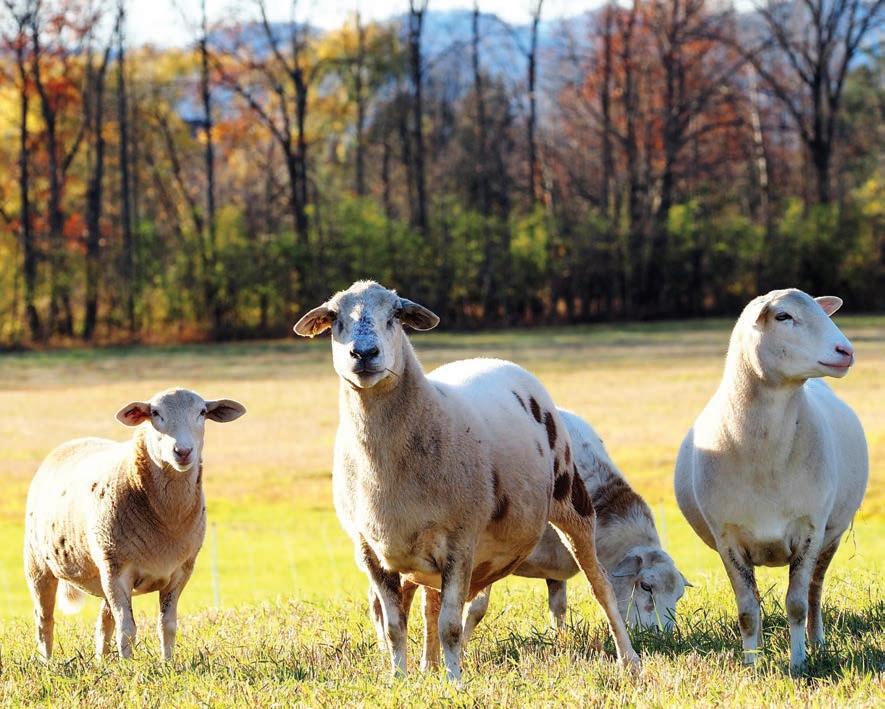
Tonight, Thursday, Nov. 21, the Pierson Library is offering two different programs.
For jammers and musicians there’s the Shelburne acoustic jam where you can suggest tunes and jam out with fellow guitarists, fiddlers and the like.
For poets, there’s the November poetry salon and open mic featuring poets Glenn Etter and Julia Alter. Then, the floor opens for all to share their unique voice and poetry. Both programs go from 6-8 p.m. The jam will be held in the large community room and the salon will be in town hall.
Have a much-loved stuffy that needs a mend? The library is continuing to take in beloved teddy bears, plushies and lovies in need of rehabilitation for the rest of this month. The Velveteen Rabbit will pick them up, mend them and return them to the library for your retrieval.
Death cafes are opportunities to gather and ponder the thorny subject of mortality.
Lead by Dr. Nick Marconi, these safe and intimate chats help people find community, voice concerns and reflect upon the beauty and discomfort of their finite lives.
The next one is Saturday, Nov. 24, from 2-4 p.m. Space is limited to 12. To register, call the library at 802-985-5124.
DJ Diplodocus is back for a dance through the decades. The first songs will be from the 1940s, and then the ’50s, ’60s, ’70s, ’80s and all the way up to the latest dancehall hits of the 2020s.
This is a great way to find community, discover new music, fuel nostalgia and get in some light aerobics as the nights continue to grow longer and the days shorter.
This dance party takes place Tuesday, Nov. 26, 6-8 p.m.
Shelburne’s annual holiday tree lighting is Friday, Dec. 6.
There will be caroling, tree lighting, refreshments, crafts, model train display, SD Ireland’s lighted cement mixer, Northern Bronze Handbells, and a visit with Santa.
Come play and connect with others. No pre-registration necessary, just sign in at the door. A parent or caregiver must always be present.
Scooters, bikes and ride-on toys are not permitted. There will be balls, hoops and tumbling mats. Wear indoor shoes or socks inside the gym. No food is allowed.
In case of inclement weather, call 802-985-9551 to check for cancellations.
The free open gym for toddlers
continued from page 8
the Housing and Homelessness Alliance of Vermont, and Falko Schilling, advocacy director with ACLU Vermont.
They will discuss the June 2024 decision upholding ordinances in Grants Pass, Ore., that
and preschoolers. Sessions are Sundays, Nov. 24 and Dec. 15, 9:30-11 a.m. More dates are scheduled for 2025 so check our website for more details.
The volunteer coordinator is Aisha Mueller, and the program is held at Shelburne town gym.
Registration for seventh and eighth graders is open now. Registration for fifth and sixth graders will open on Nov. 20 for any remaining spots.
Space on the bus is limited. Chaperones are needed to run this program so consider volunteering if you sign up your child.
Two sessions will be offered: session A includes Jan. 8, 15, 22 and 29; session B includes Feb. 12, and March 5, 12 and 19.
Complete details and pric-
ing can be found at shelburnevt. org/183/youth-programs.
Stay active and healthy during the icy and cold winter months by walking in a safe and warm environment — the town gym — on Monday, Wednesday and Friday through April 2, 9-10:30 a.m.
Bring a pair of clean, dry softsoled shoes with you and change before entering the gym. No registration is required. Shelburne residents only. Note that the schedule is subject to change. Call 802-9859551 for an updated schedule or check the calendar on the gym door as there are blackout dates due to other scheduled events.
Learn more at shelburnevt. org/160/parks-recreation or call 802-985-9551.






prohibit people who are homeless from using blankets, pillows or cardboard boxes for protection from the elements while sleeping within city limits. Justices agreed with the city that ordinances enforcing camping regulations against homeless people do not violate the Constitution’s ban on cruel and unusual punishment. Send questions in advance to league@lwvofvt.org or through chat during the event. To register, go to kellogghubbard.org.






• Find out about sales and events
Sign up for our Friday EMAIL NEWSLETTER
Headlines and news sent directly to your inbox every Friday at 10 a.m.
Sign in and add your weekly newsletter: VTCNG.com/users/admin/mailinglist

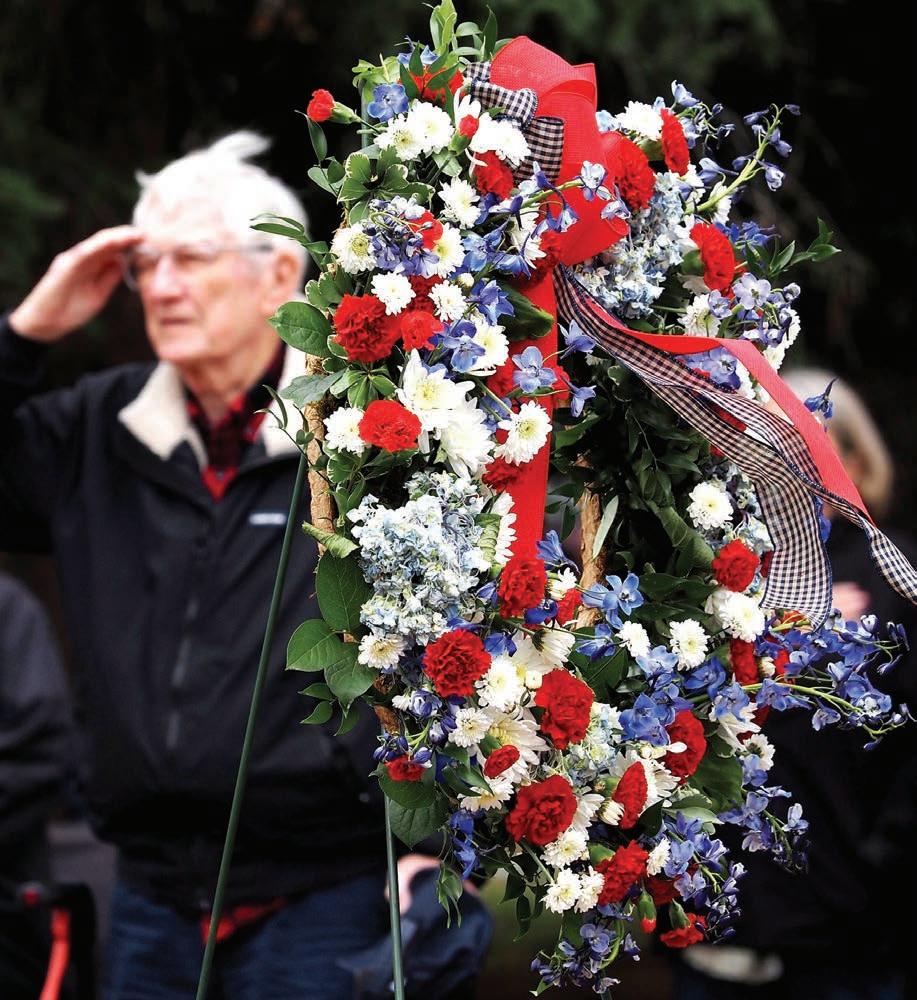


Over 60 people gathered on Nov. 11 to observe the Veterans Day ceremony at the Shelburne Veteran’s Memorial on the town’s Parade Ground.
Brigadier Gen. Henry (Hank) Harder, a member of the Shelburne Veterans Committee, opened the ceremony at 11 a.m. under mostly dry skies, and Tom Little served once again as master of ceremonies.
The main address was given by Shelburne native and Champlain Valley Union High School graduate, retired Master Chief Petty Officer Scott Wooster. He outlined his impressive naval career, which
focused on nuclear propulsion, including two circumnavigations of the globe, with humor and poignancy.
Lorraine Paul sang the National Anthem, “America,” and Colleen Haag read an opening prayer. Paul Goodrich and Peter Gadue placed the ceremonial wreath on the monument.
The committee thanked all of those who made the event possible, and especially all the veterans who have served their country.
Jane Kunin is a member of the Shelburne Veterans Committee and daughter of World War II veteran Arthur Kunin, who still attends each year for these ceremonies.

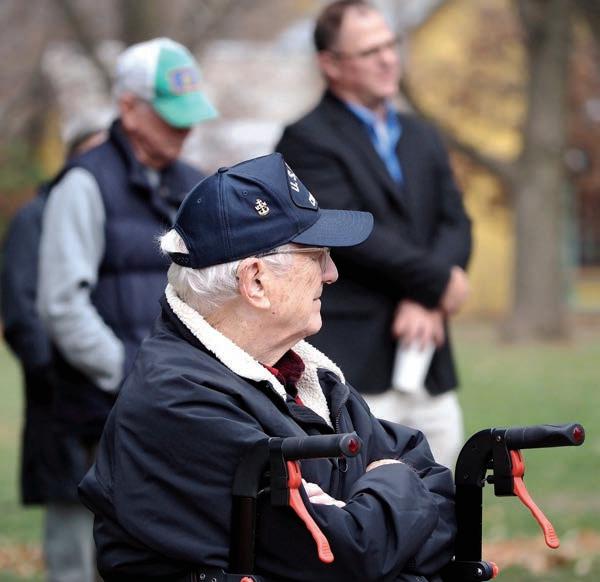
Editor’s note: Local photographer Paul Rogers, who grew up in Stowe, last year took our readers through a journey of Stick Season in a series of essays detailing his travels throughout the area looking for images to photograph for his ongoing exploration of Vermont’s fifth “season.” It proved so popular, we’re doing it again this Stick Season.
Skies were clear and temperatures seasonal on the afternoon of a certain mid-October day, more than a dozen years ago. I was exploring a seldom-used backcountry hiking trail atop Worcester Ridge in Elmore, having fulfilled a commercial assignment by capturing beautiful Vermont views from a certain parcel of land.
Down in the valleys and along the slow-moving rivers of Lamoille County, peak foliage had come and gone, its rich autumn color fading. Higher up, hillside trees were scantily clad, though some color remained. But on that ridgeline at a couple thousand feet, trees were fully bare, fully transitioned.
The calendar indicated that we were still in mid-October, so I had not yet undertaken any late-autumn, photo treasure hunts. November would be the time for such journeys.
Being yet early in late autumn — and close to home — it hadn’t occurred to me that I could simply climb a bit and step into a local expression of stick season. So, I wasn’t intentionally pursuing photos that day to include in my on-going project of the same name.
Even so, I was about to stumble upon a subject I knew well. And I was about to make a photograph of importance to my project, one that would enrich a group of images that tells a story of Vermont between fall foliage and the onset of winter.
Leaving the trail to begin my trip back, I noticed a lone figure at the same viewpoint I had visited earlier: In a clearing nestled between birches and firs, he was perched on a remnant of weathered plywood, enjoying the grand eastern view of a landscape in transition. It didn’t take me long to identify him as Rusty DeWees.
My shout of “Russ?” earned his reply of “Paul!” He’d seen my Outback parked just below, reckoning that I was somewhere on the mountain. As his photographer for nearly 25 years, I’d known him as one of Vermont’s best-known entertainers. But I’d also known him since the third grade simply as a friend.

Actor and entertainer Rusty DeWees atop the Worcester Range overlooking the Green Mountains during stick season.
No longer 8 years old, we’d sometimes meet at his barn to chew the fat, his cigar at the ready for just the right moment. We would also run into each other at seemingly random places, as one does with friends, at grocery stores, fairs or farm markets. Not surprising then that we might one day also meet on a mountaintop.
Quick with a smile and a kind word, Rusty was at rest, keeping his post-workout-self warm with a Darn Tough cap. And he was about to light up a stogie.
Rusty likes a quality cigar. Years later I would buy him a cigar while on assignment in Cuba (legal during the Trump years). Knowing that my five-dollar investment, even near the source, wouldn’t purchase a premium smoke, I’d later ask him, how was it? He’d pondered thoughtfully, genuinely, then tell me it was a good tractor cigar — one to enjoy while doing chores. The answer would sit well with me.
Anyhow, up there on Worcester Ridge we chatted for a moment as I considered the photographic possibilities of the scene before me. Though not one to take advantage of friends with my camera, especially friends who are well known, I found the scene just too good to go unrecorded.
Subject obliging (as he always was) and camera at hand, my off-camera flash was also needed, because in a landscape that was bright toward the Woodbury Mountains in the southeast, my subject sat in the deep shadows of late afternoon. The hand-held strobe would bring light to that darkness, simulating direct sunlight if positioned away from the camera and directed toward Rusty.
A little turn of the head by the experienced actor, a puff of smoke, and a few flashes of light were all it took. Pronto! A series of environmental portraits came into being … stick season portraits, as I now recognize them.
Four weeks later, in the heart of stick season, Rusty would be cigared-up once again. We were gathered with friends on the dark eve of his birthday, sitting a tolerable distance from bonfire flames that reached higher than a Vermont white pine. The blaze could be easily seen across the valley, such was the initial burn of that summer-long gathering of brush.
In fact, invitee Pete Wilder delayed his arrival to photograph the spectacle from a couple of miles away. The bonfire would initiate enough emergency calls from helpful citizenry to warrant a courtesy
PHOTO BY PAUL ROGERS
visit from a representative of the local fire department, proper burn permit and requisite pre-fire phone call to the sheriff notwithstanding.
That wouldn’t be the last Elmore bonfire I’d attend, nor the last photos of Rusty I’d make for my Stick Season Project. But looking at those 2012 ridgetop portraits in the rearview mirror has changed my perspective on late autumn photography, changed what I consider stick season opportunities.
No longer so concerned whether late-October, branch-clinging leaves might disqualify my photos on philosophical grounds, or whether late-November, ground-hugging snow might do the same, I continue to open myself to the photographic possibilities of this liminal time of year.
With or without a camera, I join my fellow Vermonters in enjoying the quietness and uniqueness of late autumn, when the demands of busier seasons are left behind and the rush of winter is not yet here. Through the chores and holidays, harvests and hunting seasons, we reflect on the passing of seasons and gaze upon an unadorned landscape and its people.
Stick season is where we find it.













continued from page 1
burne, however, and the vehicle bridge on Falls Road, with its narrow shoulder and fast-moving traffic, was dangerous for those who tried to commute by bike or foot.
Without a safe way for pedestrians to travel, Boehmcke said there was a concern that new residents would just use their cars, which was counterproductive to Shelburne’s vision of becoming a pedestrian friendly town.
When Boehmcke began advocating for the bridge as a new member of the Bike and Pedestrian Paths Committee, he was told his daughter would be in college before it gets built. Boehmcke laughed, not yet privy to the slow-turning wheel of building public infrastructure.
The loop follows trails from Falls Road down to a suspension bridge — known as the troll bridge to some — that connects another network of trails in the woods. Eventually, it dumps out at the road again and, before the bridge was built, hikers lost the serenity of nature for stressful crossing at the bridge.
“It’s really beautiful around here and a lot of people like to hike that loop, but it felt really unsafe once you hit the road,” Anderson said. “The bridge makes that loop even better.”
“It’s always been a sketchy situation to cross this bridge, so this is nice to see.”
— Travis Vogel
Fourteen years later — his daughter now a freshman in college — the bridge officially opened, much to the excitement of the nearby residents.
The pedestrian bridge runs parallel to the vehicle bridge on Falls Road and connects a network of nearby sidewalks and trails, creating a direct path into Shelburne and a scenic loop for walkers and bikers who want to enjoy the LaPlatte River.
“It’s always been a sketchy situation to cross this bridge, so this is nice to see,” Travis Vogel, a Shelburne resident who likes to ride bikes with his wife and kids, said.
AnnMarie Anderson is another Shelburne resident who likes to hike near the LaPlatte River. She said the bridge links a favorite loop of hers that begins and ends on either side of the bridge.
Despite the years of planning, the bridge only took a few hours to install last month. It was prefabricated by a company in Minnesota and shipped to Shelburne, where a crane suspended the bridge as crews bolted it to concrete foundations on either side of the river.
During Saturday’s ceremony, participants guessed at the bridge’s weight and length in gummy bears. Shelburne town manager Matt Lawless also gave away the original blueprints for the bridge as a memento.
The bridge took so long to build for a variety of reasons, but it was mostly due to increasing project costs over the years, which skyrocketed during the pandemic, according to Boehmcke. Initial cost estimates years ago were around $400,000, but the project cost a little over $1 million.
About 80 percent of cost was covered through a series of state grants, but Shelburne was on the hook for the remainder, Boehmcke said.
As prices increased, the select-
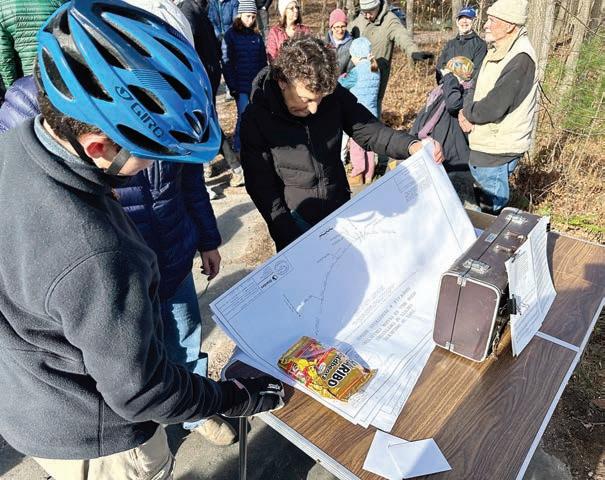
board was hesitant to burn through American Rescue Plan Act Funds that were earmarked for pedestrian pathways. Eventually, funding came together through a voter-approved bond of $168,000.
The selectboard finally approved a bid for the project last
continued from page 3
major connector could prove difficult since this intersection of road is not technically owned by the city of South Burlington but is instead a state-owned highway.
“The towns have very little control over the design,” Weber said. “But they have a lot of control over whether we engage with the state in a planning process for Shelburne Road. They have a lot of control over whether they ask for that process to start.”
The petition asks that South Burlington, Shelburne and Burlington’s leaders work together with regional planners to form a task force to address what advocates say are infrastructure issues contributing to crashes.
Weber noted that long-term solutions could include corridor length improvements, reducing the number of lanes, and improving bus services and amenities.
While the group has used petitions to respond to legislative priorities and policies before, Weber said this petition is an exceptional instance in which an “emergency situation”
December, although the vote was not unanimous; Matt Wormser voted against the project. At the time, he said Shelburne has grand plans to update pedestrian paths throughout town, and the bridge, with its demanding price tag, was only one part of the greater vision.
Boehmcke agreed that the bridge is “only one spoke on the wheel,” and the Bike and Pedestrian Paths Committee still has a lot of work to do. Nonetheless, he said the opening of the bridge was a big win for pedestrian safety in Shelburne.
has pushed for change. While there has been some pushback from residents about aspects of longer-term solutions — like lane reductions — most of the responses have been supportive.
Shelburne Selectboard chair
Mike Ashooh has long been a proponent for bike and pedestrian safety in Shelburne and actively uses bicycling as a main form of transportation.
He said after that the petition was launched, he wrote to Weber personally expressing overwhelming support for the collaboration.
“I can’t speak for the board, but I support the whole idea of it, 100 percent,” he said.
“It is scary enough when you have these little four-foot-wide shoulders because it’s just enough to tempt you to ride on the road, and just enough to be scary as hell when you’re doing it. Then you get to that intersection, and the shoulder completely disappears. Suddenly, you’re in no man’s land, and there’s nowhere to go. I’m not pointing the finger at South Burlington, but this is a serious issue.”
While members of Local Motion and other advocacy
groups attended neighboring Burlington’s city council meeting Monday to urge the council to act, South Burlington City Council chair Tim Barritt told residents that the city should consider waiting for any reports from the state police regarding the investigation.
City manager Jessie Baker pointed to several existing efforts currently underway in the city to look at improving how community members traverse public roads, sidewalks, and paths.
“These include the City’s Active Transportation Plan, an effort with Chittenden County Regional Planning Commission to specifically review technical safety for crossing Shelburne Road and, of course, our Safe Routes to School Task Force and our Bicycle and Pedestrian Committee.”
She said the city would welcome the opportunity to join a future conversation with regional leaders and neighbors to talk about how, through education and infrastructure change, “we can ensure that all are safe on our public roads, sidewalks, and paths.”
Elise Tillinghast
My friend Terry Gulick, who died earlier this year, used to tease me about my favorite yard tree. Terry did a lot of gardening jobs, when he wasn’t mentoring kids, and he was amused — and a little offended — by what I’d allowed to grow up in my former vegetable patch. It was bad enough that I was letting a tree take over prime soil, but did it have to be a boxelder?
“It’s a trash tree,” he told me, shaking his head.
Boxelder (Acer negundo), also known as ash-leaf maple, elf maple, Manitoba maple and other, less printable names — is the misfit cousin of the Acer family. It’s the only maple species that won’t sprout in shade, and you’re more likely to find specimens growing in a scraggly line along a road or riverbank than deep in a forest.
senescence, is on a human scale. A 75-year-old boxelder is already an old tree. It grows quickly in good soil, more than 2 feet in height each year, and this trait, along with its toughness, has made boxelder a popular choice for erosion control and wind break plantings.
Trash seems a harsh epithet for a tree, but the species surely inspires a lot of trash talk. One reason is the low value of boxelder wood. On the plus side, carvers appreciate its softness and its occasional pinkto-red staining. However, the wood is too weak to be useful for most construction and manufacturing purposes. It’s also low density, which makes it a poor choice for firewood beyond the kindling stage.
Because many of the samaras linger on their stems late into winter, they offer an easily accessible food for year-round resident birds and for cold weather visitors that fly down from Canada.
It’s also the only maple that’s dioecious, meaning that every tree produces exclusively male or female flowers. Its leaflets look like nothing you’d find on the side of a syrup bottle or, despite the tree’s alternative name, on an ash tree. They’re toothy, with a strong resemblance to poison ivy leaves.
Unlike the stately sugar maple, which can endure for more than four centuries, boxelder’s typical lifespan, from seed through
The most intense criticisms of boxelder come from people such as Gulick, who have spent hours cleaning up after it. A U.S. Forest Service profile of the species notes its reputation as a “dirty tree,” and if you skim through field books, you’ll find numerous disparaging references to the species’ vulnerability to rot, its complicity as a host of home-invading boxelder bugs, its tendency to scatter wind-snapped twigs, and the way it spread seeds with bunny-like abandon.
For Gulick, boxelder’s voluminous seed production was its greatest sin. Sure enough, just as he warned me would happen, my

female tree was already bearing seeds by its eighth year, and every autumn since has produced a bigger crop. As I write this, there are thousands upon thousands of samaras dangling in clusters. I think they’re pretty. And birds love them.
Because many of the samaras linger on their stems late into winter, they offer an easily accessible food for year-round resident birds and for cold weather visitors that fly down from Canada. For instance, the evening grosbeak, which breeds in Canada and has been in steep population decline, is partial to boxelder seeds. If for no other reason than to help this threatened bird, the tree deserves space in my yard.
There are other, personal
reasons I have for loving this tree. The boxelder appeared in my daughter’s first year, soon after I gave up the garden. It has grown vigorously, just as she and her younger brother have, the pencil marks on the kitchen door tracking their rising heights. The boxelder’s forked trunk, which split into a trident 2 feet off the ground, formed just the right holds for small hands and feet.
Gulick was good to my kids, and to other people’s kids who needed him more. He taught children who had a lot of sadness in their lives how to pitch tents, climb trees and roast s’mores on the fire.
could sleep at night, knowing that was growing in my yard.
But the joke’s on him. When I look at my crooked, scrappy tree, its samaras metallic in the low November light, I hear Gulick’s voice and remember his kindness.
to advertise call 985-3091 or email advertising@shelburnenews.com

When I asked about these experiences, he’d deflect and ask how I
Elise Tillinghast is the past executive director and editor of the Center for Northern Woodlands Education and is currently editor-at-large for nature and the environment at Brandeis University Press. Illustration by Adelaide Murphy Tyrol. The Outside Story is assigned and edited by Northern Woodlands magazine and sponsored by the Wellborn Ecology Fund of New Hampshire Charitable Foundation, nhcf.org.















Earn Double Points + 10% of your purchase donated to FROM November 23-November 30 (Shop Local).

OPEN 10am-9pm Daily @ Essex Experience Join Our
Cannabis has not been analyzed or approved by the Food and Drug Administration (FDA). For use by individuals 21 years of age and older or registered qualifying patient only. KEEP THIS PRODUCT AWAY FROM CHILDREN AND PETS. DO NOT USE IF PREGNANT OR BREASTFEEDING. Possession or use of cannabis may carry significant legal penalties in some jurisdictions and under federal law. It may not be transported outside of the state of Vermont. The effects of edible cannabis may be delayed by two hours or more. Cannabis may be habit forming and can impair concentration, coordination, and judgment. Persons 25 years and younger may be more likely to experience harm to the developing brain. It is against the law to drive or operate machinery when under the influence of this product. National Poison Control Center 1-800-222-1222. magicmann.com

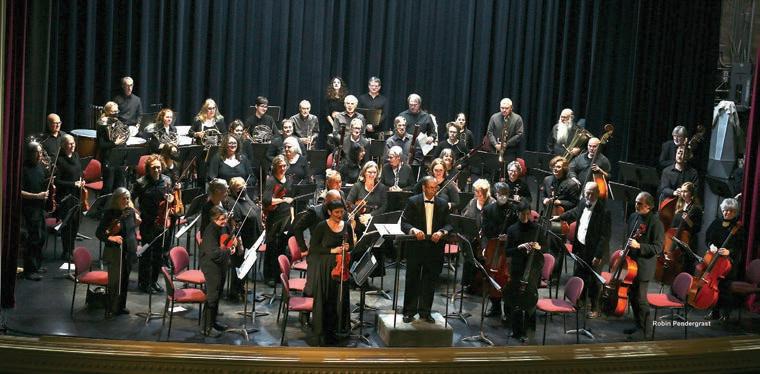
As Vermont enters the season of cold and dark, Handel’s beloved Messiah brings warmth, light and joy. Conducted by Lisa Jablow, the Vermont Philharmonic Orchestra and Chorus will present two performances to put everyone in the holiday spirit, on Friday, Dec. 6 at 7:30 p.m. in St Augustine’s Church in Montpelier, and on Sunday, Dec. 8, at 2 p.m. in the Barre Opera House.
The Philharmonic will perform the entire first part of Messiah, with arias and choral numbers that contemplate the idea
of a messiah, foretell the coming and hail the arrival. The concert concludes with the beloved “Hallelujah” chorus from Part II, and six numbers from Part III celebrating redemption.
The soloists are familiar to Vermonters, including Lillian Broderick, soprano, Lori Marino, alto, Michael Halloran, tenor, and Erik Kronke, bass. Mary Jane Austin is the assistant choral director.
Get tickets at vermontphilharmonic.com and at the door.
OLIVIA HAGIOS VTDIGGER
Department of Fish & Wildlife officials say the deer population is robust, and hunters are primed for success as they head to the woods for the start of the annual deer rifle season.
“There are a good number of deer out there, certainly more than we’ve had the last few years,” Fish & Wildlife biologist Nick Fortin said. He said it can be hard to predict harvest numbers, but anecdotal evidence suggests there are more bucks this year.
The two-week period, commonly known as rifle season to Vermont hunters, allows for a hunter to take one legal buck until Dec. 1, according to the department.
While Vermont hunters don’t need to be aware of any regulation changes going into this season, Fortin said he encourages them to give the department a tooth from any deer they take. This can be done at any check station and helps the department gather valuable age information about Vermont’s deer herd, according to Fortin, who is also the department’s deer project leader.
However, even if a hunter doesn’t take a deer this year, they can still provide useful information by contributing to the department’s deer hunter effort and sighting survey. It’s part of an annual effort to collect information from hunters, such as how many hours a day they spend hunting and how much wildlife — including deer, moose, bears, and turkeys — they see. The survey will be available for participants
to complete on the department’s website beginning Saturday.
Hunters can be found all around the state — while Orleans and Essex counties have the highest percentage of hunter participation — with 12 percent of all Vermonters hunting. Of those 12 percent, around 79 percent of those resident hunters hunt deer, according to department data.
During the COVID-19 pandemic, participation in Vermont hunting and other outdoors activities increased, however, the department is now seeing those numbers return to pre-pandemic figures, according to Christopher Saunders, fish and wildlife project coordinator for the department.
When asked about what Vermont hunting could look like in the future, Saunders said he foresees an overall decline in hunter participation in Vermont as the state’s demographics continue to change.
However, hunting is still an “important part of Vermont’s landscape,” Saunders said. “What we’re feeling in Vermont isn’t as dramatic as other places.”
While Saturday marks the first day of the November regular season, Vermonters have been on the hunt for white-tailed deer since October for the archery, Youth Deer Weekend, Novice Weekend and muzzleloader antler portions of the hunting season.
One of the biggest things to remember for the upcoming season is to wear hunter orange when out in the woods, Fortin said. This applies not only to hunters, but also to anyone in the woods where there may be hunting activity taking place.
“Get out there and have fun,” Fortin said, “but most importantly, be safe.”